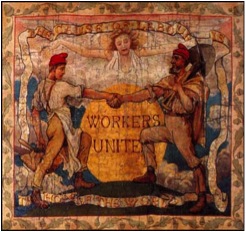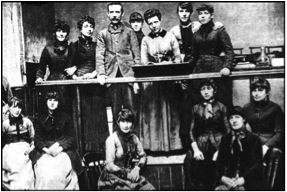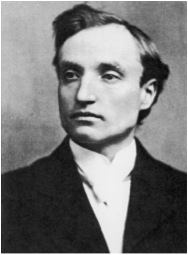Pete Goddard and Atul Hatwal continue their look at the development of the unions and their role in founding the Labour party
By the mid-1880s, the establishment had got over the initial panic stirred by the emergence of unions. Civilisation had not collapsed and revolution, like coffee in tiny, tiny cups and the ability to pass a football for more than 30 seconds before launching it into orbit, remained strictly a continental phenomenon.
Even the arrival of a couple of actual, real live working class people in Parliament in 1874 hadn’t been too traumatic. From the vantage point of the Tory benches, the Lib-Labbers’, Alexander Macdonald and Thomas Burt, looked respectable enough and it made a nice change to have someone around who could do something about that squeaky door in the lobby.
The calm was not to last.
A new, angry, voice was about to make itself heard on behalf of the unskilled workers. This new unionism was exemplified by three significant groups: the match girls, the gas workers and the dockers
At the Bryant and May factory in Bow, East London, the workers were largely young women who were casual workers. This did not mean that every day was a dress-down Friday. It meant they worked 14 hour days for less than five shillings a week, and had even fewer rights than most other workers. So less fun even than dress down Friday, then.
On the other hand, they did get to experience one of the period’s most advanced motivational programmes – a range of harsh, arbitrary fines for tiny infractions. For example, turning up late for work meant a fine of a half day’s pay.
On top of all this, the work itself was unusually hazardous. The phosphorous used to make the matches caused yellowing of the skin and hair loss. Worse still was phossy jaw, which may sound like a popular hip hop artist, but is actually a form of bone cancer. The whole side of the face would turn green and then black, discharging foul-smelling pus. And then you died.
Even by Victorian standards, this was a bit much.
Following an exposé of this horror by Fabian socialist Annie Beasant, there was a public outcry.
The firm had two choices: to do something to improve the appalling conditions or force their workforce to sign their names to a statement declaring that pus-free faces were hugely overrated and they didn’t really want to live past 30 anyway.
Management considered these options. Then ordered a big box of pens.
The workers refused to sign. Bryant and May responded in traditional fashion – sacking the organiser of the refuseniks.
Then, to the shock of bosses and the joy of headline-punsters everywhere, the match girls decided to strike. 1400 women walked out.
After three weeks of action, management caved in. They agreed to re-employ the sacked organiser and end the fines system. They hadn’t budged on the “killing your workforce with deadly phosphorous” thing, but a win was a win and the newly unionised match girls returned to work, triumphant.
These plucky women inspired other workers. In March 1889, down the road in Beckton, lay-offs from the local gas works prompted a meeting of gas employees from across the city.
Working conditions had been dreadful for years: 12 hour days, seven days a week were standard, although employees did get a lot of days off for hospitalisation and death, which were commonplace.
Remembering the match girls, Will Thorne stood up at the 1889 meeting and proposed a gas workers’ union.

The Gas Workers Union banner – in which workers congratulate one another on their stylish ‘Papa Smurf’ headgear
Thorne was a member of Henry Hyndman’s Social Democratic Federation and a gas worker himself. Within days he found himself at the head of the new National Union of Gasworkers & General Labourers. It had over 1000 members and was the forerunner of today’s GMB.
The new union opened negotiations with the Gas Light and Coke Company. Without the need for a strike, and before anyone could even make the “Coke is It” joke, Thorne had negotiated a new standard 8 hour day for the gas workers.
It was a stunning endorsement of the power of collective bargaining.
First the match girls, then the gas workers. It could only have been more metaphorically apt if the next group to unionise had been the tinderbox makers.
Actually, next up were the dockers, led by Ben Tillett. Tillett had helped set up the gas workers’ union and was already general secretary of the small Tea Operatives and General Labourers association. In summer 1889, he became involved in a dispute over pay and conditions at London’s docks.
Prior to the strike, dock workers were literally starving – workers would work their first hour of the day and then claim their wages for that hour in order to get something to eat just so they could get through the day. That was if they had work at all. Casual hiring practices meant dockers would be kept waiting until called for work, and paid nothing if there was no labour that day.
The dockers struck, demanding their wage be raised from “a pittance” to “a pittance you might survive on” – specifically 6p an hour, known as “the Dockers’ tanner”. That is the equivalent to what might be earned by a small child in a trainer factory today.
Over 100,000 men went on strike but, without any money, it looked like the bosses would be able to starve the dockers back to work. The day was saved by a donation of £30,000 from the Australian dockers to their British comrades’ cause.
Suddenly the prospect of a prolonged strike loomed. Once again, the bosses capitulated, an event the dockers probably would have celebrated if they hadn’t had to get right back to work in order to be able to buy something to eat.

The “call on” for dock workers wanting labour. Or the worst Punch and Judy show ever. One of the two
These three new union successes spurred a massive rise in union interest. From 750,000 in 1888, trade union membership grew to 1.5 million by 1892 and to over 2 million by 1899.
There was an unfortunate side effect of this, though. Lord Salisbury’s Conservative party got scared. They began appointing anti-union judges who made a series of high profile union-hostile legal rulings.
This saved the Conservatives the inconvenience of having to put any new laws through parliament and let everyone know exactly who was in charge.
Alarmed, the unions began looking for different ways in which they might protect their new-found strength.
The Amalgamated Society of Railway Servants had an idea. The unions could team up with prominent Socialist groups to create a parliamentary body that could represent their interests.
They could call it, I dunno, the Labour party, or something.
Pete and Atul are not historians
Tags: Atul Hatwal, Labour history uncut, match girls, Pete Goddard, strike, Unions










